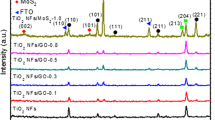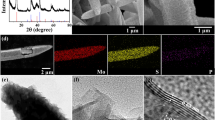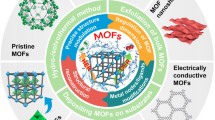Abstract
A simple method to fabricate Mo-based nanostructures were developed by the thermal decomposition of MoO x -based organic–inorganic hybrid nanowires. Well-defined Mo-based nanostructures, including MoO2 and MoO3 nanowires, can be prepared by changing the hybrid precursor. More importantly, Mo2C/MoO2 heterostructures with porous structure were successfully synthesized under an inert atmosphere. The resultant Mo2C/MoO2 heterostructures show enhanced electrocatalytic activity and superior stability for electrochemical hydrogen evolution from water. The enhanced performance might be ascribed to the high electrical conductivity and porous structures with one-dimensional structure. Indeed, our result described here provides a new way to synthesize other Mo-based nanostructures for various applications.
中文摘要
钼基纳米材料因其特殊的结 构和良好的化学性质被广泛应用于传感器和催化领域. 其中, 碳化钼 具有类似贵金属的电子结 构和催化特性, 受到了越来越多的关注. 在本研究工作中, 通过对有机-无机复合材料在惰性气氛下进行热处理, 制备了不同的一维钼氧 化物纳米材料以及碳化钼/氧化钼多孔异质纳米材 料. 析氢电催化性能表明碳化钼/氧化钼多孔异质材料显示出优异的氢析出性能和循 环稳定性. 此方法制备过程简单有效且适合大量制备, 同时为制备新型钼基纳米材料提供了新的思路.
Similar content being viewed by others
References
Yang H, Sun C, Qiao S, et al. Anatase TiO2 single crystals with a large percentage of reactive facets. Nature, 2008, 453: 638–641
Shi Y, Guo B, Corr SA, et al. Ordered mesoporous metallic MoO2 materials with highly reversible lithium storage capacity. Nano Lett, 2009, 9: 4215–4220
Hercule KM, Wei Q, Khan AM, et al. Synergistic effect of hierarchical nanostructured MoO2/Co(OH)2 with largely enhanced pseudocapacitor cyclability. Nano Lett, 2013, 13, 5685–5691
Gao M, Chan M, Sun Y. Edge-terminated molybdenum disulfide with a 9.4-Å interlayer spacing for electrochemical hydrogen production. Nat Commun, 2015, 6: 7493–7501
Wen X, Yang W, Ding Y, et al. Piezoresistive effect in MoO3 nanobelts and its application in strain-enhanced oxygen sensors. Nano Res, 2014, 7: 180–189
Buscnma M, Steele GA, van der Zant HSJ, et al. The effect of the substrate on the Raman and photoluminescence emission of single- layer MoS2. Nano Res, 2014, 7: 561–567
Gastellanos-Gomez A, van der Zant HSJ, Steele GA. Folded MoS2 layers with reduced interlayer coupling. Nano Res, 2014, 7: 572–578
Sun Y, Hu X, Luo W, Huang Y. Self-assembled hierarchical MoO2/graphene nanoarchitectures and their application as a high-performance anode material for lithium-ion battery. ACS Nano, 2011, 5: 7100–7107
Hu B, Mai L, Chen W, et al. From MoO3 nanobelts to MoO2 nanorods: structure transformation and electrical transport. ACS Nano, 2009, 3: 478–482
Walter MG, Warren EL, McKone JR, et al. Solar water splitting cells. Chem Rev, 2010, 110: 6446–6473
Dempsey JL, Brunschwig BS, Winkler JR, Gray HB. Hydrogen evolution catalyzed by cobaloximes. Acc Chem Res, 2009, 42: 1995–2004
Hao R, Jiang B, Li M, et al. Fabrication of mixed-crystalline-phase spindle-like TiO2 for enhanced photocatalytic hydrogen production. Sci China Mater, 2015, 58: 363–369
Yin Y, Zhao S, Zhao K, et al. Ultrathin platinum nanowires grown on single-layered nickel hydroxide with high hydrogen evolution activity. Nat Commun, 2015, 6: 6430–6438
Millet P, Andolfatto F, Durand R. Design and performance of a solid polymer electrolyte water electrolyzer. Int J Hydrogen Energy, 1996, 21: 87–93
Benck JD, Chen Z, Kuritzky LY, et al. Amorphous molybdenum sulfide catalysts for electrochemical hydrogen production: insights into the origin of their catalytic activity. ACS Catal, 2012, 2: 1916–1923
Xie J, Zhang J, Li S, et al. Controllable disorder engineering in oxygen- incorporated MoS2 ultrathin nanosheets for efficient hydrogen evolution. J Am Chem Soc, 2013, 135: 17881–17888
Yang Y, Wang S, Zhang J, et al. Nanosheet-assembled MoSe2 and S-doped MoSe2–x nanostructures for superior lithium storage properties and hydrogen evolution reactions. Inorg Chem Front, 2015, 2: 931–937
Gao Q, Zhao X, Xiao Y, et al. A mild route to mesoporous Mo2C-C hybrid nanospheres for high performance lithium-ion batteries. Nanoscale, 2014, 6: 6151–6157
Liang CH, Ying PL, Li C. Nanostructured β-Mo2C prepared by carbothermal hydrogen reduction on ultrahigh surface area carbon material. Chem Mater, 2002, 14: 3148–3151
Kolel-Veetil MK, Qadri SB, Osofsky M, et al. Formation of a superconducting mixture of β-Mo2C nanoparticles and carbon nanotubes in an amorphous matrix of molybdenum compounds by the pyrolysis of a molybdenum derivative of a carboranylenesiloxane. Chem Mater, 2005, 17: 6101–6107
Lunkenbein T, Rosenthal D, Otremba T, et al. Access to ordered porous molybdenum oxycarbide/carbon nanocomposites. Angew Chem Int Ed, 2012, 51: 12892–12896
Wolden CA, Pickerell A, Gawai T, et al. Synthesis of β-Mo2C thin films. ACS Appl Mater Interfaces, 2011, 3: 517–521
Pang M, Chen X, Xu Q. MoCx species embedded in ordered mesoporous silica framework with hierarchical structure for hydrogenation of naphthalene. Applied Catalysis A General, 2015, 490: 146–152
Xing Z, Liu Q, Asiri AM, Sun X. Closely interconnected network of molybdenum phosphide nanoparticles: a highly efficient electrocatalyst for generating hydrogen from water. Adv Mater, 2014, 26: 5702–5707
Liao L, Wang S, Xiao J, et al. A nanoporous molybdenum carbide nanowire as an electrocatalyst for hydrogen evolution reaction. Energy Environ Sci, 2014, 7: 387–392
Gao Q, Zhang C, Xie S, et al. Synthesis of nanoporous molybdenum carbide nanowires based on organic–inorganic hybrid nanocomposites with sub-nanometer periodic structures. Chem Mater, 2009, 21: 5560–5562
Chen WF, Wang CH, Sasaki K, et al. Highly active and durable nanostructured molybdenum carbide electrocatalysts for hydrogen production. Energy Environ Sci, 2013, 6: 943–951
Li D, Zhang Y, Li L, et al. Polydopamine directed MnOai]C microstructures as electrode for lithium ion battery. Sci China Chem, 2015, doi: 10.1007/s11426-015-5439-1
Jin Q, Pei L, Hu Y, et al. Solvo/hydrothermal preparation of MnOxai] rGO nanocomposites for electrocatalytic oxygen reduction. Acta Chim Sinica, 2014, 72: 920–926
Zhao D, Li Z, Liu L, et al. Progress of preparation and application of graphene/carbon nanotube composite materials. Acta Chim Sinica, 2014, 72: 185–200
Wang X, Li B, Liu D, et al. ZnWO4 nanocrystals/reduced graphene oxide hybrids: synthesis and their application for Li ion batteries. Sci China Chem, 2014, 57: 185–200
Ni JF, Zhao Y, Li L, Mai L. Ultrathin MoO2 nanosheets for superior lithium storage. Nano Energy, 2015, 11: 122–126
Wu L, Wang X, Sun Y, et al. Flawed MoO2 belts transformed from MoO3 on a graphene template for the hydrogen evolution reaction. Nanoscale, 2015, 7: 7040–7044
Mokari T, Rothenberg E, Popov I, et al. Selective growth of metal tips onto semiconductor quantum rods and tetrapods. Science, 2004, 304: 1787–1790
Peng S, Li L, Han X, et al. Cobalt sulfide nanosheet/graphene/carbon nanotube nanocomposites as flexible electrodes for hydrogen evolution. Angew Chem Int Ed, 2014, 53: 12594–12599
Wang RH, Yang J, Shi KY, et al. Single-step pyrolytic preparation of Mo2C/graphitic carbon nanocomposite as catalyst carrier for the direct liquid-feed fuel cells. RSC Adv, 2013, 3: 4771–4777
Pang M, Li C, Ding L, et al. Microwave-assisted preparation of Mo2C/CNTs nanocomposites as efficient electrocatalyst supports for oxygen reduction reaction. Ind Eng Chem Res, 2010, 49: 4169–4174
Yang Y, Zhang Z, Wang P, et al. Hierarchical MnO2/SnO2 heterostructures for a novel free-standing ternary thermite membrane. Inorg Chem, 2013, 52: 9449–9455
Xu B, Yang H, Zhou G, Wang X. Strong metal-support interaction in size-controlled monodisperse palladium-hematite nanoheterostructures during a liquid-solid heterogeneous catalysis. Sci C hina Mater, 2014, 57: 34–41
Zhang H, Wang K, Wu X, et al. MoO2/Mo2C heteronanotubes function as high-performance Li-ion battery electrode. Adv Funct Mater, 2014, 24: 3399–2404
Gao Q, Wang S, Fang H, et al. One-dimensional growth of MoOxbased organic–inorganic hybrid nanowires with tunable photochromic properties. J Mater Chem, 2012, 22: 4709–4715
Lin YC, Zhang W, Huang JK, et al. Wafer-scale MoS2 thin layers prepared by MoO3 sulfurization. Nanoscale, 2012, 4: 6637–6641
Sen UK, Shaligram A, Mitra S. Intercalation anode material for lithium ion battery based on molybdenum dioxide. ACS Appl Mat Interfaces, 2014, 6: 14311–14319
Vrubel H, Merki D, Hu X. Hydrogen evolution catalyzed by MoS3 and MoS2 particles. Energy Environ Sci, 2012, 5: 6136–6144
Li Y, Wang H, Xie L, et al. MoS2 nanoparticles grown on graphene: an advanced catalyst for the hydrogen evolution reaction. J Am Chem Soc, 2011, 133: 7296–7299
Liao L, Zhu J, Bian X, et al. MoS2 formed on mesoporous graphene as a highly active catalyst for hydrogen evolution. Adv Funct Mater, 2013, 23: 5326–5333
Dempsey JL, Brunschwig BS, Winkler JR, Gray HB. Hydrogen evolution catalyzed by cobaloximes. Acc Chem Res, 2009, 42: 1995–2004
Author information
Authors and Affiliations
Corresponding author
Additional information
Yang Yong was born in 1987. He received his BSc and MSc degrees from the College of Chemical Engineering, Northwest University in 2009 and 2012, respectively. His research interests are focused on the design and synthesis of Mo-based nanostructures for energy related applications.
Wang Xun is currently a professor at the Department of Chemistry, Tsinghua University, Beijing, China. He got his PhD degree in Chemistry from the Department of Chemistry, Tsinghua University in 2004. His research interests focus on the synthesis, assembly, characterization and application of ultrathin nanomaterials.
Electronic supplementary material
Rights and permissions
About this article
Cite this article
Yang, Y., Xu, X. & Wang, X. Synthesis of Mo-based nanostructures from organic-inorganic hybrid with enhanced electrochemical for water splitting. Sci. China Mater. 58, 775–784 (2015). https://doi.org/10.1007/s40843-015-0088-4
Received:
Accepted:
Published:
Issue Date:
DOI: https://doi.org/10.1007/s40843-015-0088-4




